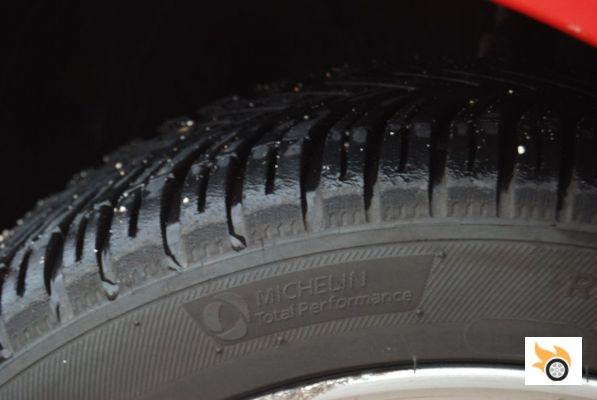With an average temperature of less than 7 degrees the winter compounds are better, and above that the summer ones. Most Spaniards normally use summer tyres, a few weirdos consider using winter tyres seasonally, and another minority use "all-season" tyres because their car comes with them as standard (like some SUVs) or because they prefer a middle ground: the tyres don't go 100% any day of the year.
That's why I decided to try Michelin's all-season tires, the CrossClimate. After a year of testing and about 15,000 kilometers driven, I can give some conclusions that are more than preliminary. I've faced sunny days, heavy rain, unsalted snow, sleet... a bit of everything. Let's see if the expectations of grip, mileage, comfort, year-round versatility and so on are met.
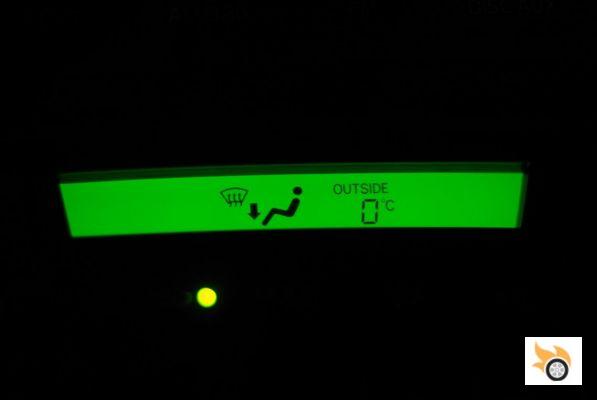
Throughout last summer the tyres behaved almost as well as if they were conventional summer tyres. Despite the aggressiveness of the tread, which looks like a tractor's rear wheel, they are not noisier, nor do they wear out quickly, and the car's tread is practically the same as always. Even in sporty driving they are reliable tyres, they warn me in good time before I deviate from the trajectory.
The most noticeable effect I started to notice with the new tyres was a reduction in fuel consumption. The homologation of these tyres in dimension 225/45 R17 94W is C, that is to say, a medium term. I had just removed from the front axle some wheels with E rating (width 215), and yes, it has been noticed. Last summer (June to September) I averaged 6.22 l/100 km on LPG, compared to 6.63 l/100 km for the same period last year. That's a saving of 0.4 l/100 km or 7% less.
But more surprising is this data. In the same period in 2014 I was still using Goodyear EfficientGrip front axle tyres, with B fuel consumption approval, and at that time my average was 6.05 l/100 km. Also, those tyres were 210mm wide. So even though the CrossClimate are 15mm wider and have less favourable homologation, the difference was barely noticeable. In both 2014 and 2015 I was still using Goodyear EfficientGrip on the rear axle, so I've only talked about the front tyres, which is what has changed.
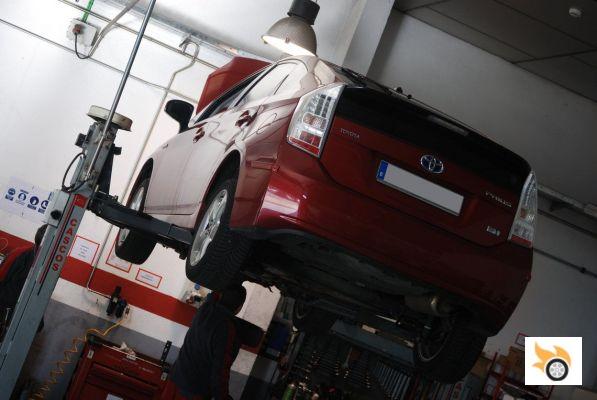
On the occasion of the winter, it was time for a general review of the car, the 150,000 kilometers, and I went to my usual place, the Kobe Motor dealership in Villalba. I took the opportunity to look for any defect that could alter for the worse the wear of the tires. Toyota mechanics only found the front brake pads at the limit, which were the standard ones (2009), and proceeded to put new ones. This would dispel any doubts about the effectiveness of the brakes when drawing conclusions. The rest was all in order.
When it started to cool down, well into November, the temperature in the area is already 7 degrees or lower, a time when the summer tires begin to lose more performance due to hardening of the rubber. On mornings when it was bitterly cold there was a noticeable difference in performance, the CrossClimate's performed much more like the rest of the year. The lowest temperature I saw on the gauge was -4°C, and I'd say I pretty much missed it as far as the tyres were concerned. The Goodyear EfficientGrip tires tended to lose more grip in roundabouts and without fast or aggressive driving, which is normal for tires of this type.
With winter homologation, if chains are required, with these tyres it is not necessary (nor recommended).
It's not an area where snow is a big threat, actually there are very few days a year when I have problems, and it's a very relative problem, because the snowplough usually passes before yours truly. One morning I found snow everywhere, enough to have problems with normal tyres, but not enough for chains. The moment was immortalized with this tweet:
I had commented in first impressions that they are quiet, but if you concentrate you can hear a faint sound when the sidewalls are working. Keep in mind that the Prius is a bit quieter than a normal car, most likely an average driver with a normal car won't even notice this noise. In any case it is never annoying, if at all noticeable.
Later I faced layers of virgin snow in more complicated conditions, streets without the passage of snowploughs in Cercedilla, one of the coldest places in this area. I did the same test as I did with the Supra with 100% winter tyres, starting uphill to check its efficiency. Then the Supra went uphill in first gear without any difficulty, but it has to be said that it doesn't have electronic traction assistance and it has a self-locking differential.
With the Prius I tried to go uphill and the traction was much worse. The traction control noticed a loss of ditto and started to cap the engine power and apply the brakes. It's the same feeling as once I got stranded on beach sand, moving forward was practically impossible. I have to say something that isn't obvious: it's not the fault of the tires, but of the car itself.
The Prius 3g is one of the few cars I've driven that has no button or menu to disable traction control. This means I always have it on, and in conditions where you have to let the wheels slip to dig in, this car cannot. In fact, a front-wheel drive with intelligent traction control (like a PSA with Grip Control) in its snow program would have made progress, because it allows controlled wheel slip. I consulted with a Michelin expert and he explained that I would have had the same problem with pure winter tires.
I didn't have that problem of mobility on another occasion when I came across a street where the snow plough hadn't passed, with less slope, where I entered with some inertia and the car advanced with hardly any difficulty, practically as if I had been wearing chains at that moment. I had tried the most difficult yet: from a standstill, uphill and with a traction control that acted as an anchor. The result would have been very different without the electronic assistance, which is what happened with the old Supra.
Another test I did was to brake a bit sharply on a layer of snow of a few centimetres. The braking was logically longer than on clear tarmac, but not as long as if it had been with summer tyres, where the ABS would have let the tyre slide much more. Apart from the tests and forced situations, I can easily say that I could forget about the outside temperature. I was feeling it in the form of cold in the passenger compartment, as the Prius takes longer to generate heat for the heating because it has the habit of turning off the engine. In the mornings, until I hit the highway, I don't even get 50 degrees of coolant, so logically I notice the scratch. The wheels don't.
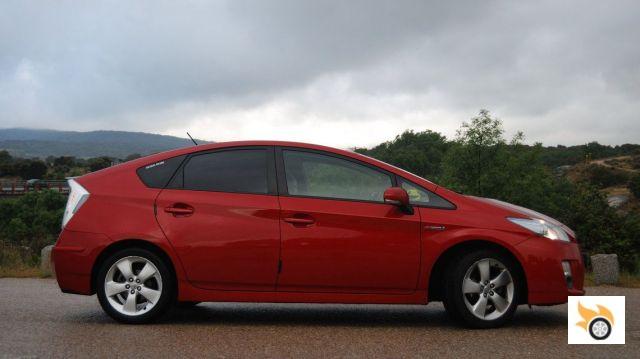
During the coldest period, from November to the end of January, I noticed an increase in consumption (6.7 l/100 km), but I can't blame it so much on the tyres, but on the car itself. I have already noticed that in the Prius the consumption always goes up in winter, and the reason is obvious: the engine loses more heat and more gasoline (LPG in this case) has to be used to maintain an adequate level. The effect is partially disguised because I keep the radiator covered almost all year round, but the cold sneaks in through other places besides the front air intake.
Compared to pure winter tyres, the CrossClimate are clearly quieter. There's also a noticeable difference in that the steering wheel feels less rough. In other words, in my personal case, I wouldn't have noticed any appreciable advantages if I had been driving with conventional winter tyres, like the Alpin ones I use on my other car: I'd spend more, I'd have more noise and in terms of mobility I'd stay more or less as I am.
As soon as the temperature started to stabilize to more or less spring-like levels, the reduction in fuel consumption has been noticeable. I've also noticed it doing long distance trips, where I usually go very loaded because I share seats in Blablacar and I don't have so easy to consume little (more highway, less city). From March to now the average has dropped to 6.5 l/100 km. My worst tank, and giving him cane, I have not passed 7.8 l/100 km. I insist that this is LPG, the equivalent in petrol is less than 6 l/100 km.
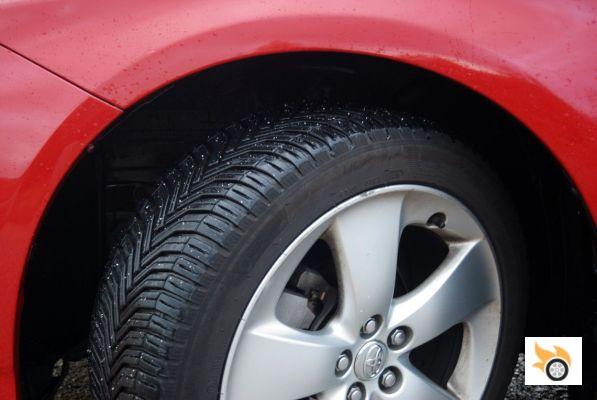
Let me talk a bit about wet conditions, which are more common than snow. I haven't driven on pure ice at any time (and I'm thankful). On water they should theoretically be great, because their wet rating is A, the best in the table. And so it is, I took advantage of a day when some rafts formed to attack them at 90 km / h and the steering remained very stable and without deviating. On water I ride with a lot of confidence, even more than with the Pirelli Pzero Nero I used before on the front axle.
I did notice a bit more understeer at the limit or under hard braking. I put it down to the fact that now I have wider tyres, because I have 225 on both axles, so it's totally normal that in these conditions I'm penalized compared to narrower tyres like the Goodyear. The standard size (215/45 R17) is a bit weird and I had to use compatible sizes, which has not been a problem in ITV or having a front and rear size (the regulations left it to the discretion of the inspector of the station).
Anyway, all cars go worse when it rains and mine is no exception. In the absence of being able to make a more serious measurement, I'll leave it at "it seemed to me that", because with the brakes of this car so little powerful I have never had the feeling of braking on a sheet of paper. It has its justification, with regenerative braking is that I hardly use the pads or discs, that's why I have lasted 150,000 kilometers the original pads. In addition, the shock absorbers are still the standard ones, and that also has its consequences when braking.
Anyway, the days that it has rained the most I've been using press cars, so I haven't driven as many kilometers as I would like with these wheels in those conditions. Apart from that personal impression, they go as they should: very well. And that brings us to how they have worn.
After 15,000 kilometers I measured a tread depth of about 6 millimeters on all four tires, considering that the fronts usually last about half as long as the rears on this model. I've used an eye gauge, there are decimals, but on the front wheels the figure is slightly less than 6mm, but not quite 5.5mm. The rears have slightly less wear. As for the tread, the sidewalls have a bit more punished grooves, but that's due to the way I take roundabouts... a bit fast if the traffic allows me to.
Snow efficiency is supposed to start to be lost when there is less than 4mm of groove depth.
Considering the wear rate of my previous front sets, it's quite likely I can go up to 50,000 miles on the front axle, the same as the Goodyear lasted, whereas the Pirelli said enough with about 30,000 miles (3mm of groove). As things are, it doesn't make sense for me to swap front and rear, the wear is being very homogeneous. I'll give wear data later, around 30,000 kilometers.
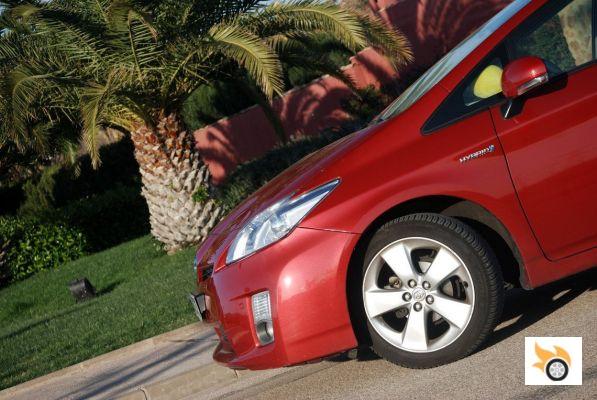
Conclusions after a year of use
In a more compact and summarized way, as summer tyres they are perfect, and in winter conditions I practically have the advantages of summer and winter tyres, without the drawbacks of one or the other. Without being able to remove traction control I can not enjoy 100% of the performance that has the tread on snow, it's a shame.
The fuel consumption is practically the same as I had with wheels of higher energy category (B) and with 15 mm less width. What's more, in winter conditions the pure summer ones (B) gave me the same fuel consumption as the CrossClimate (C), so mathematics in hand, the Michelin are more efficient when temperatures drop: the rubber gets less hard, the engine makes less effort.
I haven't noticed any adverse effect compared to the tyres I used before, neither compared to the EfficientGrip (HP) nor compared to the Pzero Nero (UHP). Whether I'm riding slowly in electric mode or easily exceeding 120 km/h, in all circumstances they prove to be tyres with a degree of versatility that I haven't seen since I started riding.
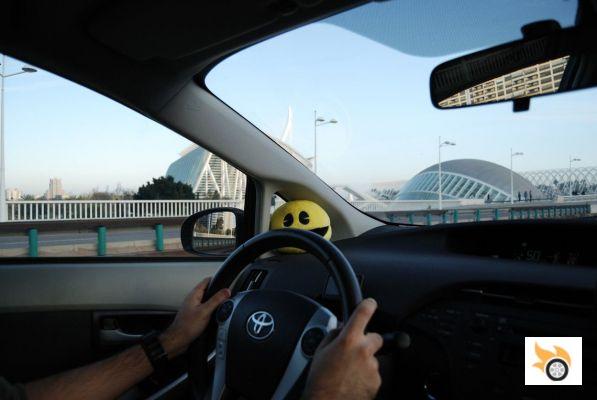
They meet all the expectations advertised by the manufacturer, there's no catch and no fuss.
And they are not outrageously expensive either! The recommended price (that always goes down in practice) is 125 euros per wheel according to Michelin's website, very much in the average of what wheels of that size (225/45 R17) are worth in summer sizes. Unless a technologically superior model appears, for strictly personal purposes I would not consider trying any other model of tire. Right now I can say that this is the ideal tyre for me.
I'm still wondering if they will last 50,000 kilometers or not, because the central tread holds perfectly, but I doubt a little about the sidewalls, they may wear out faster due to the aggressiveness of the tread. I'll check it as the odometer progresses. I have been checking the pressures every two or three months, as they are tires with little tendency to deflate, I have never gone below 2 bars of pressure.
To all that said, add that I have not found any negative comments about the Michelin CrossClimate, even in Forocoches speak well of them. Last year they presented their evolution, CrossClimate+, with a different compound. I don't see any reason to switch to the new compound, although I have the exact size for my car, they are more expensive and don't improve neither the efficiency in water nor the fuel economy, although it seems that the compound lasts more kilometers. We'll see.
